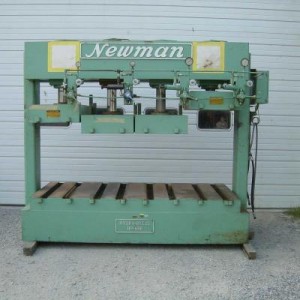 Most woodworking operations have a wood press, with its size and mode of operation depending on the type of pressing needed. But, regardless of why an operation needs a press, its few breakable parts, rigid construction, and long lifespan make it an excellent machine to buy used, as long as the necessary considerations and precautions are made prior to purchase.
Most woodworking operations have a wood press, with its size and mode of operation depending on the type of pressing needed. But, regardless of why an operation needs a press, its few breakable parts, rigid construction, and long lifespan make it an excellent machine to buy used, as long as the necessary considerations and precautions are made prior to purchase.
Choosing the Right Model for the Job
In many ways, choosing a press is straightforward: you need one that offers the right pressure, width, length, and height. On the low end, a mini pod model, a small, box-shaped press, could do the trick, but probably not if you’ll press pieces that are more than two feet wide and over three feet long; while on the high end, a large side loading model that offers superior pressing dimensions could be the answer. Whatever model meets your needs, it’s important to ask how it fits within your existing workspace, especially for models that take up significant floor space.
Unlike other machines, presses typically aren’t upgraded as a result of an increase in production demand, but due to the addition of another woodworking practice, such as ply wood making. But it still pays to invest in a larger workspace instead of cramming your current one with a large press, especially if it’s is the machinery centerpiece of your new endeavor, a situation that could easily see your other machinery eventually upgrade to the level of your press.
Considerations for Buying Used Presses
Along with pallet storage equipment and line equipment, industrial pressers are some of the top woodworking equipment in terms of lifespan. But, if your presser will contain a motor, as a high pressure one commonly does; it’s best to look at like at a presser as you would any other machine, taking steps to insure its reliability. To this end, there are four valuable tips for choosing used machinery that offers new machine quality at a used machine price.
1. Buy from Professional Sellers and Not Amateur Ones
The greatest risk with buying from an amateur is purchasing a machine whose condition hasn’t been properly evaluated, a problem that doesn’t exist when you buy from a professional seller of used woodworking machines. Common examples of amateur sellers include amateur eBay merchants, non-professional sellers on Craigslist and other websites, and auctioneers who expect bidders to have the knowledge required to make an informed purchase.
2. Check a Sellers’ Record at the Better Business Bureau (BBB)
Checking a seller’s record at the BBB can tell you lots about how it treats its customers, as well as how many problems they experience with its products. If you find that a seller has unresolved customer complaints on its record, it could mean that customer satisfaction is low on its list of priorities. But it definitely means that customers reported problems that were never resolved, a bad situation by any standard.
3. Request a Copy of Machine’s Maintenance Record
Some presses require little maintenance, but motorized ones require as much as other machines. If you review a press’s maintenance record and find it spotty, search until you find one that’s spotless. Nothing predicts a machine’s future reliability like a great maintenance record.
4. Inspect a Machine Firsthand Before Buying it
Because photographs sometimes don’t tell the whole story of a machine’s appearance in terms of wear, it’s wise to take a first person look at what you’re buying before you buy it, or have a knowledgeable third party take a look on your behalf.




